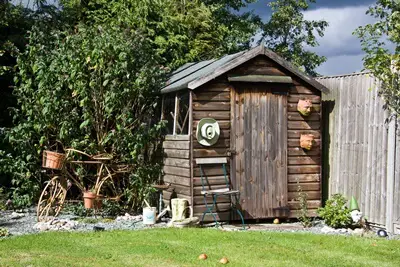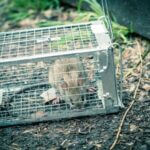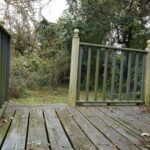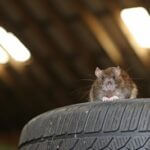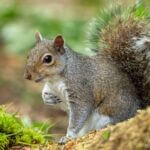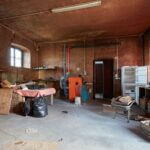Rats enjoy living in/under sheds because they’re quiet and dark, see little activity, serve as shelter, and often have available food and water.
You’ll know that rats are under the shed if you find burrows, droppings, gnaw marks, rub marks, and nests. When rats are present, you can take steps to drive them out.
Once the shed has been rat-proofed, target the rats more directly by setting humane rat traps or using poisons to kill them.
After doing this, you’ll need to take steps to keep the rats (or others in the area) from targeting your shed.
How Do I Get Rid Of Rats Under My Shed
Rats can cause a lot of damage to your shed, often due to burrowing underneath them to locate food and shelter. If left unchecked, they’ll multiply, putting your shed, yard, and home at risk.
Here’s how to get rid of rats from under the shed without calling an exterminator:
Seal Cracks Under Holes Under The Shed
Start by surveying the perimeter of your shed for holes and cracks that rats might use to enter your shed’s foundation.
According to the University of California, rats can squeeze through any opening at least ½ inch in diameter. Once you identify any potential entry points, block them to prevent more rats from entering your shed.
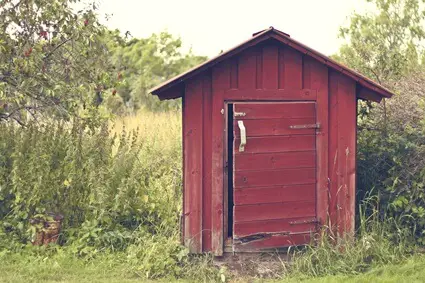
Clean and Arrange Your Shed
Rats like to shelter under sheds since these areas do not experience a lot of activity.
If you don’t use your shed often, it can become cluttered and dirty, thus creating the right conditions for rodents to thrive. Clean your shed to get rid of clutter and organize it to eliminate hiding places for rats.
This is also true of the area around your shed. If rats congregate underneath the foundation, look out for wood piles, stacks of gardening equipment, bags of fertilizer, and boxes.
Rats may use these to hide their entry points or live in these areas.
Destroy Rats’ Nests
Have rats infested your shed for a long time? Then, there is a high likelihood that they have set up nests where they can go every night, leading to rats breeding and multiplying.
To prevent this, destroy whatever nests you can find. This will be done by removing old boxes, cardboard, rock piles, and other items you no longer use.
Disturbing these common nesting areas will make the rats evacuate and prevent them from returning to your shed, forcing them to find a new home elsewhere.
Get Rid of Food Sources
Rats feed on anything in their immediate environment, including nuts, seeds, grains, pet food, and organic waste. Removing any food sources under the shed will discourage rats.
Remove any food sources in your shed and store pet food where rodents can’t access it. Also, ensure that your garbage cans are tightly sealed to prevent rats from accessing household food waste.
Set Snap Traps
Installing snap traps is a cost-effective and convenient way to capture and remove rats from your shed. Bait the traps with a treat that rats find irresistible.
The best food options include
- Peanut butter
- Cereals
- Bacon
- Dried fruit
Regularly change the position of your trap or use different baits after a successful catch. That’s because rats have good memories. Once they see other rats getting caught in a trap, they’ll avoid it completely.
Avoid touching the traps with your bare hands because doing so leaves a human scent, which may discourage rats from approaching a trap.
Rat Poison
Rat poison is one of the most effective ways of getting rid of rodents. Most rat poisons are also toxic to humans, so they may cause severe illness or death when inhaled, ingested, or exposed to the skin.
Be sure to dispose of the dead rats in a sealable plastic bag once you are done.
You should also remember to clean your hands with soap and running water. Store any unused rodenticides where children cannot access them.
Signs Of Rats Under The Shed
Since rats are most active at night, you may not see them in your shed during the daytime. However, several tale-tale signs can tell you whether you have rats in your shed. These include the following:
Burrows
Brown rats prefer to live underground.
They dig burrows and subterranean pathways to avoid run-ins with humans and predators. If you notice holes in the ground about 2-4 inches in diameter, you may have rats on your property.
Droppings And Urine
Rats often leave droppings on the paths and other areas they frequent.
In a single day, rats can leave up to 40 droppings, which are sausage-shaped and measure between ½-¾ of an inch in length. In addition, you may notice the distinct ammonia smell of urine, which is a clear indication of rats.
Gnaw Marks
Rats, like all rodents, have long incisors that never stop growing. As a result, they constantly gnaw on hard objects to file their teeth, which helps prevent the teeth from growing out of proportion.
So, if you have rats living in your shed, you’ll notice gnaw marks on the following:
- Walls
- Floorboards
- Stored objects, such as boxes
- Furniture
- Metal appliances
Rub Marks
Rats tend to leave greasy marks on objects when they rub against them with their bodies. Places where you’re likely to find rub marks are floorboards and walls.
Nests
Rats will shred fabrics, cardboard, paper, and insulation material to build nests. So, if you notice bits and pieces of material strewn all over your shed, chances are, you have rats.
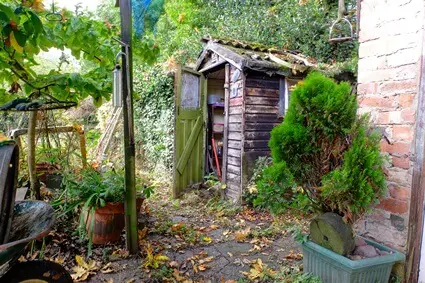
How To Keep Rats From Getting Under The Shed
Dealing with rats can be a costly and time-consuming affair. That’s especially true if you have a large rat population on your property.
Take precautions to stop rats from entering the shed:
Remove Attractants
Rodents are more likely to get under your shed if there are food sources for them to enjoy. If you tend to leave pet food or dog poop in the open, this can encourage rats to set up a home under your shed.
Ensure that all possible food sources are secured, including pet feeding bowls and garbage cans.
Water Supply Removal
Rats are attracted to areas that have reliable water sources. If there are any damaged and leaking pipes or unsecured water bowls around your shed, rats will build nests nearby, giving them easy access to these resources.
Hire a plumber to fix any leaking pipes and pets’ water bowls out of reach to avoid this problem.
Cleaning And Yard Maintenance
Failing to clean up and maintain your yard provides the perfect environment for rodents to thrive.
After all, they can easily hide in the tall grass and under bushes. Eventually, rats will likely find their way under your shed and into your home.
Trim your grass regularly and prune any trees or shrubs close to your property. Also, cover your compost to prevent rats from using it for food.
Why Are There Rats Under My Shed?
Rats often burrow under sheds to access warm shelter, especially during the cold season.
If there are any holes or cracks in the structure of your shed, rats can squeeze through these openings to gain entry. So, block all holes in your walls and floors, no matter how small they may seem.
Having a few rats nest under your shed can attract more rodents. According to Laboratory Animal Science, rats can signal other rats through pheromones in their urine.
Failure to rat-proof your shed in the early days of an infestation can result in a worse problem. With the tips and advice above, you can take steps to safeguard your shed from rats.

